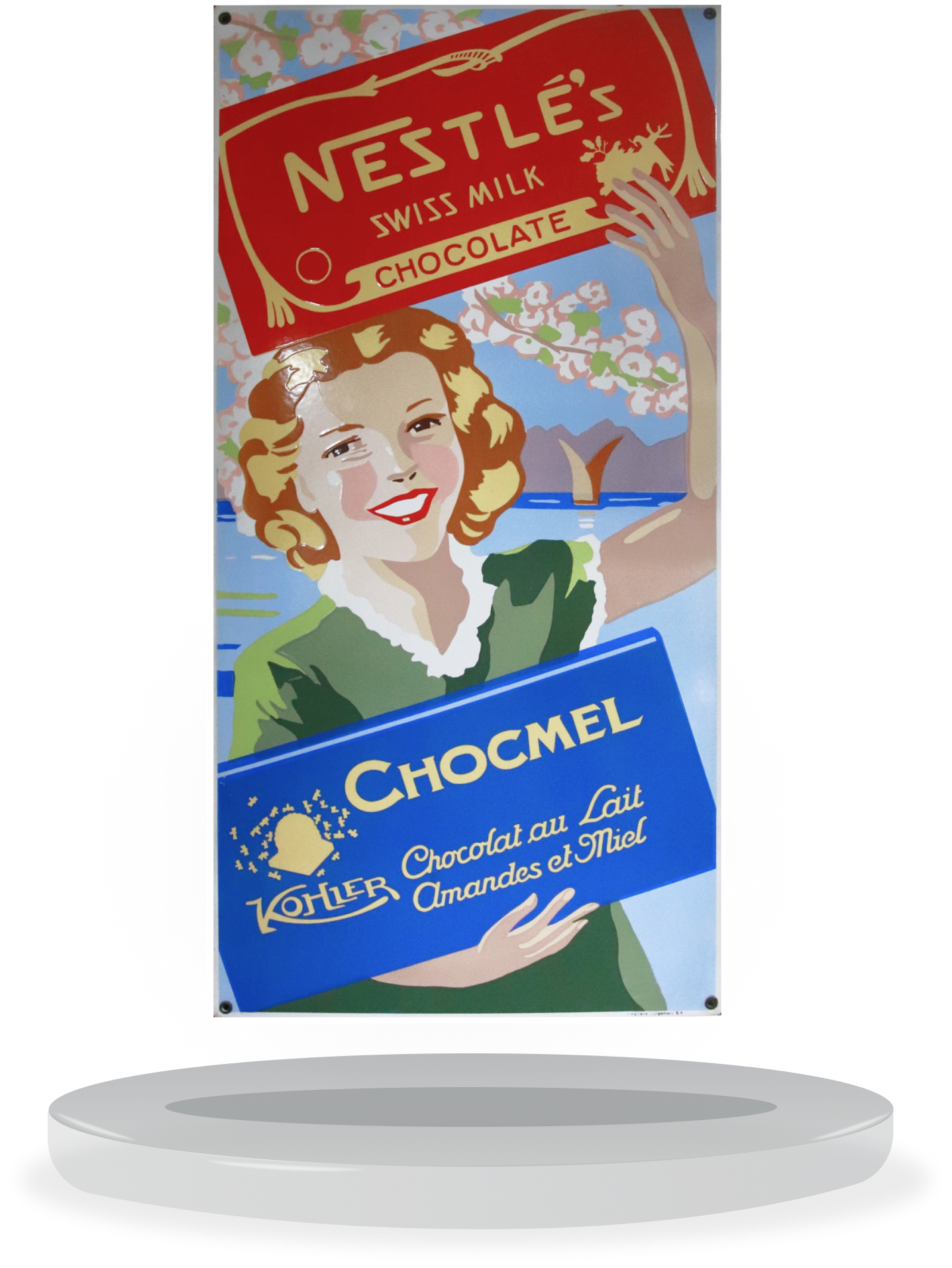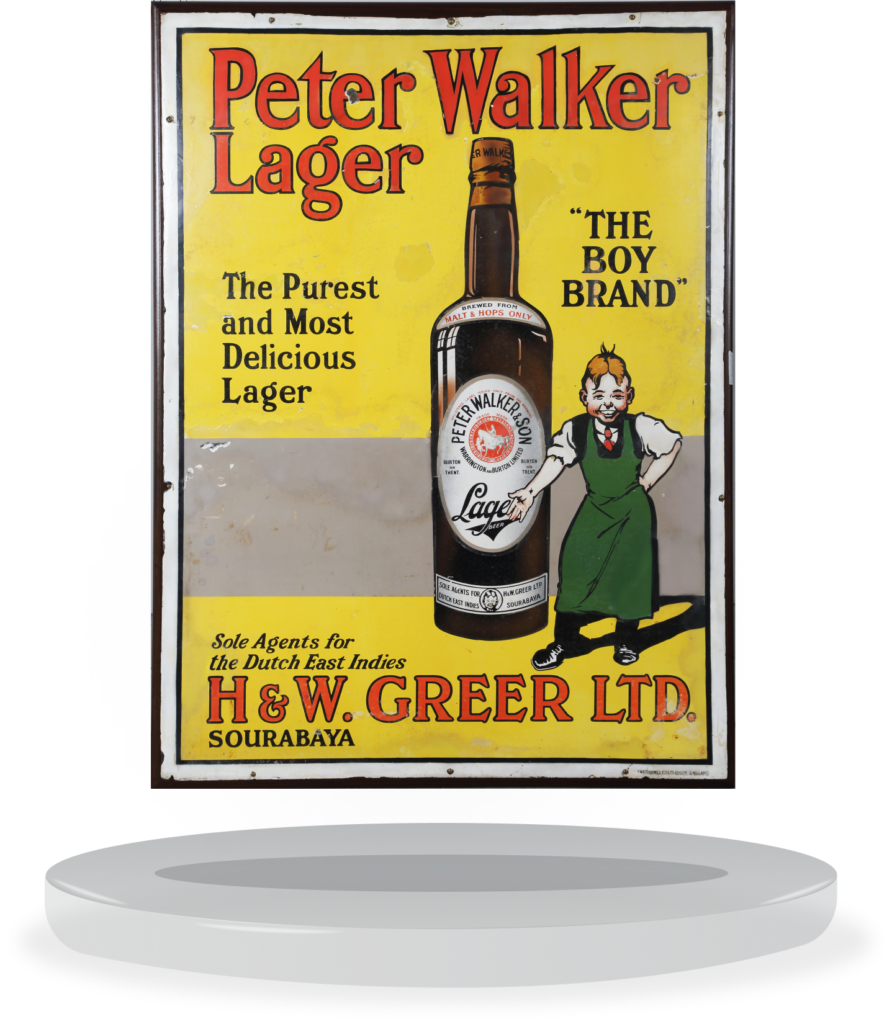
The Public Gallery is a versatile yet unconventional gallery space that welcomes collaborations between artists and curators of all backgrounds. Built thoughtfully as a hybrid between an urban venue and event space and an industrial exhibition gallery, The Public Gallery aims to build a community of creatives who dare to defy convention in their artistic practice, and know how not to take themselves too seriously with a drink in their hand.

Vintage Enamel Signs
Enamel signs emerged in the mid-1800s as a form of advertisement for food, household items, petrol and a variety of services in the United Kingdom. Signs were constructed out of vitreous enamel, involving a process where coloured glass was fused to iron plates. Enamel signs were often displayed outdoors, using catchy slogans and vivid colours to attract customers; this led them to be known as “street jewellery”.
Stores in the 1800s were often highly specialised, and relied heavily on enamel signs to not just inform shoppers about specific products for purchase, but also to act as an effective branding tool to set their wares apart from similar products. Due to advancements in printing in the 20th century, enamel signs were gradually replaced by cheaper advertising hoardings, and virtually disappeared by the 1950s.
This collection traces how vintage enamel signs document the many facets of everyday life for middle-class consumers between the 1800s to the mid-1900s. Two collections – Tasks at Home and Infant Care – investigate the domestic lives of women, while the Delicacies of the Middle Class collection offers a rare look at historic 19th century chocolate manufacturers. Or, discover the leisure activities of working and middle-class folk through the Industrial Alehouses and Travel and Transportation collections – which explore industrial drinking culture and innovations to transportation respectively.

Tasks at Home
Enamel signs emerged in the mid-1800s as a form of advertisement for food, household items, petrol and a variety of services in the United Kingdom. Signs were constructed out of vitreous enamel, involving a process where coloured glass was fused to iron plates.
Enamel signs were often displayed outdoors, using catchy slogans and vivid colours to attract customers; this led them to be known as “street jewellery”. Stores in the 1800s were often highly specialised, and relied heavily on enamel signs to not just inform shoppers about specific products for purchase, but also to act as an effective branding tool to set their wares apart from similar products. Due to advancements in printing in the 20th century, enamel signs were gradually replaced by cheaper advertising hoardings, and virtually disappeared by the 1950s.
This collection traces how vintage enamel signs document the many facets of everyday life for middle-class consumers between the 1800s to the mid-1900s. Two collections – Tasks at Home and Infant Care – investigate the domestic lives of women, while the Delicacies of the Middle Class collection offers a rare look at historic 19th century chocolate manufacturers. Or, discover the leisure activities of working and middle-class folk through the Industrial Alehouses and Travel and Transportation collections – which explore industrial drinking culture and innovations to transportation respectively.

Lux
Wall 1
Lux is a brand developed in 1899 by Lever Brothers, now known as Unilever, in Cambridge Massachusetts. The soap powder was able to perform all fine laundering work and would work with silks, satins and lace garments.
Designed to be of comparison with fine French soaps but at an affordable price, a national advertising campaign managed to receive endorsements from Hollywood actresses and this led to Lux’s claim that out of 10 Hollywood stars, 9 of them used their product.
When Hollywood actresses were no longer part of their advertising, sales fell for Lux. The business profits dipped further in the 1990s when Lever Brothers devoted their attention to another soap brand – Dove.
Although overtaken by other brands, Lux continues to be a popular household brand today.

Lux
Maker
Year of Make
Material
Country of Origin
Lever Brothers
c.1920s
Enamel
United States of America

Infant Care
Apart from household tasks, middle-class women were also faced with the myriad responsibilities of childcare. While wealthier families could hire wet nurses to feed and care for babies, most middle-class mothers could not afford this luxury and had to personally breastfeed their newborns. For mothers who were not able to breastfeed, canned condensed and evaporated milk were popular and inexpensive substitutes.
Older children could be fed half-solid foods such as Quaker Oats, or malt beverages like Horlicks and Ovaltine. Such products were not only advertised towards children, but also the elderly, invalids, and caretakers of these individuals.

Condensed Milk Milkmaid Brand
Wall 2
Condensed milk was invented in the early 1850s by Gail Borden, as a solution to the inability to store fresh milk safely for long.
The first tin cans were sold in the US, and became hugely popular. It was nutritious, portable and had a long shelf life. When US trade consul Charles Page was posted to Switzerland, he founded the Anglo-Swiss Condensed Milk Company in Cham in 1866, together with his brother George. George had learned the process for producing condensed milk, which involved heating milk to evaporate some of the water, and then adding sugar as a preservative. The Page Brothers then rolled out their condensed milk under the Milkmaid brand successfully.
Another migrant to Switzerland during the 1800s, German-Swiss confectioner Henri Nestle begun producing infant food and with his success, he also went into making condensed milk. Nestle and Anglo-Swiss were rivals until 1905, when they merged, creating the Nestle and Anglo-Swiss Condensed Milk Co.

Condensed Milk Milkmaid Brand
Maker
Year of Make
Material
Country of Origin
Nestle and Anglo-Swiss Condensed Milk Co
Early 1900s
Vintage iron enamel
Switzerland

Delicacies of Middle Class – Chocolates
The origin of chocolate dates back to 1750 BCE, when it was consumed as a drink by Mesoamerican civilisations; only in the 16th century was chocolate first brought to Europe as a result of Spanish colonial exploration. Upon arrival, it became an exotic symbol of luxury, wealth and power, since it was only accessible to aristocrats and elites.
This status remained unchanged until the Industrial Revolution, when the mechanised production of cocoa powder was invented by Dutch chocolate maker Coenraad Johannes van Houten in 1828. Van Houten’s machines allowed cocoa beans to be pulverised into a multi-purpose powder, and used as a confectionery ingredient. This discovery led to an explosion of affordable chocolate products, which were now more readily available to middle and working class families.

Nestle’s Swiss Milk Chocolate Chocmel
Wall 3
Born in Lausanne in 1790, Charles-Amédée Kohler grew up to join the family business. The Kohlers were merchants of goods and wines. He started a chocolate factory in 1830, and became a full-time chocolatier upon his father’s death. He is widely credited as the inventor of hazelnut chocolate.
His sons Charles-Amedee and Adolphe took over the business and continued to run the Kohler company when he died.The company merged with the Peter chocolate brand in 1904, and again with the Cailler chocolate brand in 1911.
In 1929, Peter, Cailler, Kohler, and Chocolats Suisses S.A. merged with the Nestle group. At the time, the Kohler chocmel range of milk chocolate was very popular and could be afforded by the middle class and Nestle continued to advertise it as one of its own products.

Nestle’s Swiss Milk Chocolate Chocmel
Maker
Year of Make
Material
Country of Origin
Nestle
c.1930s
Vintage Iron Enamel
Switzerland

Industrial Alehouses
In contrast to the domestic lives of middle-class women, 19th century working-class men spent most of their time in industrial districts. These industrial districts consisted of not just factories, but also alehouses and inns which were frequented by workers during midday breaks or after work hours.
Since drinking was the primary social activity of working-class men, many large breweries and distilleries produced enamel signs to be displayed within alehouses, as advertisements for their beverages. As customers were predominantly male, the designs of such enamel signs often depict a male figure enjoying his drink.

Peter Walker Lager
Wall 4
Peter Walker & Son was a popular British brewery which operated out of Warrington, England. Established by Peter Walker in 1846, the company was well-known for their lagers, which were exported to destinations as far as Southeast Asia and Australia.
This Peter Walker Lager enamel sign was commissioned in the 1920s by H. & W. Greer Ltd., the sole agent for Peter Walker & Son products in the Dutch East Indies. H. & W. Greer Ltd. was an active importer and distributor of beer and milk in the early 20th century, and appeared in the Singapore Directory as early as 1910. Peter Walker Lager was also known as “Boy Brand”, due to the company’s advertisements featuring illustrations of a young, smiling barkeep pointing at a case of beer.

Peter Walker Lager
Maker
Year of Make
Material
Country of Origin
H. & W. Greer Ltd., Patent Enamel Co. Ltd., Peter Walker & Son
c.1920s
Enamel Iron Plate
Indonesia, United Kingdom

Travel & Transportation
The 19th century ushered in a bicycle craze that swept across Britain and the United States. Major technological discoveries were made by French and British inventors, which enabled the mass production of bicycles and increased access to personal transportation.
For women, bicycles were a symbol of liberation. The mobility that bicycles afforded allowed women to be more visible on the streets, giving them independence from home and their husbands. With the freedom to move around, women could also take part in social activities without having to wait to be chauffeured.
Later in the century, mass production of four-wheeled automobiles made transportation much more convenient for the upper classes, and automobiles became the preferred mode of private transportation for wealthier individuals. Otherwise, the railroads and trains were also popular alternatives as public transportation.

Agency for B.S.A Bicycles
Wall 5
BSA is the Birmingham Small Arms Company, and was a major industrial group that made military weapons, bicycles, motorcycles and machine tools.
It was in 1861 that members of the Birmingham Small Arms Trade Association formed BSA to manufacture guns using machinery.
They were urged to do so by the British War Office, who then went on to award them contracts for making military arms.
BSA started making bicycles in 1880 and its factory adapted well to making bicycle parts. In 1919, BSA Cycles was established to make both bicyles and motorcyles. After the Second World War, BSA ran into trouble due to poor management. The bicycle business was sold to its competitor Raleigh in 1957. In 1973, a government-led rescue led to a takeover and the ensuing loss of many of its businesses to other firms.

Agency for B.S.A Bicycles
Maker
Year of Make
Material
Country of Origin
B.S.A Cycles
c.1920s
Vintage Iron Enamel
England
